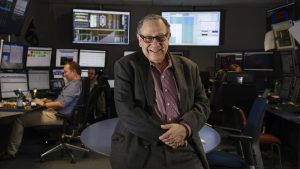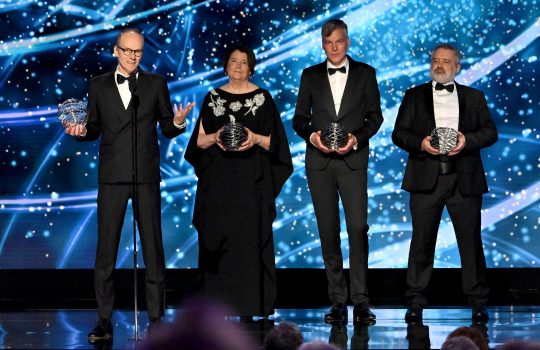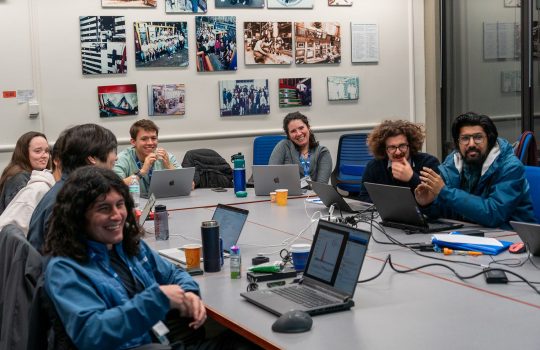While his official title might be Joel Butler, Distinguished Scientist, his tenure as the CMS spokesperson required a very different skill set than most people associate with research.
“At Fermilab, I was a famous nondelegator,” Butler said. “I liked to poke my nose into everything. But that doesn’t work when you’re overseeing a collaboration with more than 3,000 members.”
Butler started working at Fermilab in 1979 and quickly found himself managing large projects and departments. But according to Butler, nothing compares to his time at CERN as the CMS spokesperson for the last two years.
“It’s an experience very few people ever have,” said Butler. “I’ve run experiments before, but the magnitude of diversity, talent and energy on CMS is spectacular. There’s nothing like it.”
This week Butler prepares to return to Fermilab. He hands the reins of the CMS experiment over to his successor, Roberto Carlin, as well as to incoming deputy co-spokespersons Patty McBride of Fermilab and Luca Malgeri of CERN. He reflects on his time as the CMS spokesperson, lessons learned and major achievements.
***
What do the day-to-day activities look like for the CMS spokesperson?
The job of the CMS spokesperson is to keep everything going and make sure problems are solved. Every week we would go through all the detector systems to find out what the problems were and make sure we were on track to resolving them. Once a week I would also inform the collaboration with status updates and upcoming events, such as special LHC runs. That’s the job: communication with collaborators, listening to collaborators, problem solving and a lot of meetings. The CMS collaboration consists of many countries and funding agencies, and they all have different projects and priorities. The job of the spokesperson is to bring everyone together and make sure that everyone is doing the best work they can do.
What were some of the challenges that come along with being the spokesperson of a large international collaboration with 3,000-plus members?
The biggest problems were not conflicts, but rather communicating complicated ideas. The CMS experiment has a tremendous number of smart people with good arguments for what they want to do and why they want to do it. But just because someone is talking, doesn’t mean that they’re communicating. Sometimes people would leave meetings without a real understanding of what we had decided. Sometimes I’d say something extreme during a meeting just to see if people were listening. Sometimes silence is taken as consent, but other times, it’s just a lack of attention. So I started doing this thing called affirmative consensus, where silence was not consent and people had to state that they agreed.
I heard that you had “office hours” in the atrium of CERN’s Building 40 every morning. Why did you decide to do that, and what was it like?
Not exactly office hours, I just hung out there around breakfast time and hoped people would come by and talk, and often they did. The problem is that as things move up the chain, certain kinds of information get diluted, and by the time it reaches the spokesperson, you don’t hear what you need to hear. People have a tendency to filter information so that only urgent matters propagate, and persistent problems and annoyances don’t move up to management. Transparency is really important in a collaboration like this, because if we don’t know what the problems are, we cannot work toward solving them. I wanted to stress that people should not be shy about discussing their problems with me, which is why I kept my door open and tried to make myself as accessible as possible. If we put the problems out there, other people can engage and help solve them.
This was your first time managing a large international collaboration. How was it different than the projects you’ve overseen in the past?
When I was the U.S. CMS program manager, from 2007 to 2013, I worked with all the U.S. universities on CMS, which is about 30 percent of the collaboration. Because it’s the same funding environment and the university systems are similar, there was a lot of commonality and overlap in world view. Now as the CMS spokesperson, take that job and add another 48 nations, which are all really different. With U.S. universities, some are very large, and some very small. But internationally, there are even bigger differences. Many international partners have been in physics for decades, while others are just starting to get into the field. A big goal of CMS and CERN is to help develop powerful new collaborators around the world and bring the ability to do science to more and more people. The world has got smart people everywhere, but some places don’t have the pre-existing infrastructure to support them. So when it comes to working with international partners, they can have many of the same problems we see in the United States, but amplified, and they can have completely new ones. At the same time, it’s also very exciting. In an international collaboration, you get new perspectives on problems and can draw on knowledge and experience from all over the world.
What are some of the challenges CMS faced over the last two years?
While we’re always making discoveries, learning new things, and progressing the field, particle physics isn’t a discipline where we’re going to completely revolutionize our understanding of the universe every day. Progress is steady, but it often takes 10 or 20 years to go from one major breakthrough to the next. There are lots of false trails and dead ends you need to explore before you eventually hit the right path. Expectations tend to be higher than justified. Just because progress is high doesn’t mean that you’ll immediately find new physics.
What are some of the major accomplishments of CMS and the LHC over the last two years?
We’ve ruled out many theories for new physics and really enhanced our understanding of the Standard Model. We made measurements of the Higgs boson that, a few years ago, we could only have dreamed of making. It shows that patience pays off. We have a magnificent opportunity to explore the subatomic laws of nature with this machine that works so well. It’s astounding, really! I’ve been around long enough to remember when turning on an accelerator could be a matter of years. But the LHC is just fabulous. We’ve been given this miraculous device, and our responsibility is to make the most of it. Stay focused, and keep going. A breakthrough could happen at any moment or could take years.
What are you doing next?
I’m now the deputy head of a CMS upgrade that will give us precision timing of particles as they pass through the detector. This can be a tremendous asset because it will help us reconstruct events and better understand what happened during the collisions. That assignment should last around two years, and after that, I’ll see where I am. I’m near the end of my career and thinking about retirement, but I’ll never stop working. This is too much fun. I remember there was this saying from Confucius that went, “If you love what you do, you’ll never work a day in your life.” It’s true!




